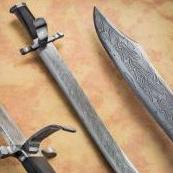-
Posts
222 -
Joined
-
Last visited
Content Type
Profiles
Forums
Articles
Gallery
Downloads
Events
Everything posted by kevin (the professor)
-
Mutt - yeah, I normally forge mine into an octagon or a square, and then forge them into a flat rectangle (pretty much like bar stock, just over 1/4" thick and 1" to 1.5" wide). It just makes sure that any voids or delams deep inside the material are stuck together. If they happen to come out rectangular to begin with, then I hammer them so that the dimensions swap, the slightly longer side of the rectangle becomes the slightly shorter side and vice versa. kc
-
Hey - I am from Texas and I lived in Austin for 2 years when I was 20-22. I am staying on 6th street! Just wondering about knife stuff while I am there. kc
-
Stanley, Damn shame I have moved away. I am from Huntsville. I bought a truck in Waller once. I will be in Austin on 17-19, is there anything in the custom knife world you would suggest I see if I get some free time while I am there? I am testifying in a trial, but maybe will be free on Friday. I am learning, and Austin is my favorite city. Let me know if anything in the knife world is a must see while I am there. take care. Loved the cable and bone knife on website. kevin

